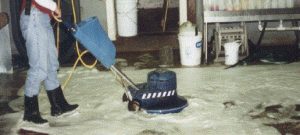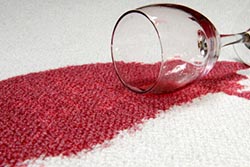Allergies and Carpet—Evidence Frequent Carpet and Upholstery Cleaning, Not Removal, is Key
The recent trend of replacing wall to wall carpeting with wood, tile, or stone floors as previously discussed has unintended consequences.
As a result of infrequent and improper cleaning and other poor maintenance practice’s, wall to wall carpeting became less desirable, leading to a large amount of it being removed, resulting in the loss of all of its inherent benefits: Warmth, upfront affordability as opposed to hard surfaces, sound absorption, dust trapping ability, general comfort, and yes, allergy relief.
In the residential market, especially, comfort and appearance are the two main driving forces, so we still like to have carpet or area rugs in our bedrooms and living areas. As I have previously stated, “Carpet Just Feels Better.”
What are the benefits of frequent carpet and upholstery cleaning?
No matter how much we try to keep our hard surface floors clean, carpet and rugs become the “trash can” for all the dirt debris, and contaminants tracked off them. Proper cleaning of these textiles restores the benefits of comfort, appearance, and allergy relief.
Why are professional carpet and upholstery cleaning necessary for allergy relief?
People suffering from allergies receive significant benefits from professional cleaning of carpet, rugs, upholstery, and other indoor furnishings. Dust mites, pollen, chemical gasses, and other allergens get trapped in these textiles from foot traffic and general air flow.
Carpet and Upholstery Cleaning Cleans your Filter
Carpet, rugs, and upholstery act as filters are cleaning the air around them. This is not something that is readily apparent. Allergy doctors for many years have mistakenly told their patients to remove the carpeting and rugs from their homes because “they are full of allergens.” But, unless these passive filters are replaced with equally effective filtration system, the occupants find indoor allergies worsen rather than improve. When you remove the “trash can” where does all the trash go?
Research Proves Benefits of Carpet with Frequent Carpet and Upholstery Cleaning
Since this finding goes against conventional wisdom, a research study was completed to verify these findings.
Michael A. Berry, Ph.D. the Deputy Director of the Environmental Criteria and Assessment Office of the Environmental Protection Agency headed such a study that he completed in January 1989.
This EPA research study was performed in the Dade County Florida public schools to determine how carpet affected indoor air quality. They compared similar school buildings with the same occupant loads, the only difference being some had new carpet installed, and the others only had hard surface floors. By the end of the study, the benefits of the carpeted buildings became apparent. Among these were the fact that in the school buildings with carpet on the floor there was a dramatic initial improvement in attendance and test scores which they came to realize was the result of the carpets ability to trap allergens, bacteria, and viruses from the air resulting in less absenteeism of teachers and students for sickness, the carpeted classrooms were also quieter which improved communication between occupants, but as the study progressed the researchers found that there was less and less of a difference in the statistical benefits between the school buildings that were carpeted and those that were not as the carpet began to exceed its limit of holding capacity of contaminants, In essence: “the trash can was overflowing” since a proper maintenance schedule of regular cleanings of the carpet had not been instituted as it should have been at the beginning of the study. By the end of the study, the quality of the air in the carpeted buildings was just as poor as it was in the buildings that only had hard surface floors.
Study Conclusions Demonstrate the Benefits of Frequent, Proper Carpet Cleaning
More Specifics by Michael A Berry Regarding Benefits of Carpet Cleaning
Quotes of Michael A. Berry Ph.D. from this 1989 research study:
“I have reached the conclusion that carpeting and fabrics not cleaned and properly maintained have the potential to cause a variety of health problems inside the building environment. From a public health perspective, I would find it impossible to justify the installation of carpets indoors without the existence of effective cleaning methods using environmentally sound cleaning technology by individuals properly trained in the application of those methods and technology. Every time carpet and fabrics are emptied of their pollution build-up through professional cleaning methods, there is a health benefit. We are also finding that typical vacuuming does not reduce fine particle contaminant levels indoors. Fine particles less than 7 microns in size pass through vacuum cleaning bags. These particles tend to build up over time and have the greatest potential to cause harm as they penetrate deep into the human lung. Until the time as carpet fibers are properly cleaned, the potential for human health risk remains high. The benefit of extraction cleaning is the overall reduction of respirable particles which cause most of these deleterious health effects, reduction of cases of biological induced illness, reduced lifetime cancer risks, and reduced health complaints and reduced liability for building owners and managers.”
EPA Guidelines for Proper Carpet Cleaning
At the end of this study, the EPA published these recommended intervals for proper extraction cleaning of carpet and flooring textiles. This is now the industry standard for professional carpet cleaners.
| Michael A. Berry PhD | ||||
| Deputy Director,
Environmental Criteria And Assessment Office |
||||
|
Environment: |
Normal |
Contaminated
Outside Dusty |
Cold Weather
Climates |
High Heat
Humidity Biogenic Climates
|
| Day Care Center | 2 wk | 1 wk | 2 wks | 1 wk |
| Nursing Homes | 1 mo. | 1 mo. | 12 mo. | 1 wk |
| Residence | ||||
| (2 persons, Non-smoking) | 6-12 mos. | 2 mos. | 4-6 mos. | 4-6 mos. |
| (2 persons, with smoking) | 4 mos. | 2 mos. | 3 mos. | 4 mos. |
| (young children) | 6 mos. | 1 mo. | 3 mos. | 3 mos. |
| (young children with pets) | 3-6 mos. | 1 mo. | 2 mos. | 2 mos. |
| Office Building: | ||||
| (ground floor) | 3-6 mos. | 1-4 mos. | 2-6 mos. | 2-6 mos. |
| (higher floors) | 3-12 mos. | 2-6 mos. | 3-9 mos. | 3-9 mos. |
| Food Service Establishments | 1 mo. | 1 wk | 2 wks | 2 wks |
| Commercial: | ||||
| (retail shops, banks) | 3-6 mos. | 1 mo. | 2 mos. | 2 mos. |
| (from US EPA Letter
January 1989) |
||||
Surprising Benefits—The Conclusions
In the 37 years that I have been a Certified Master Textile Cleaner, cleaning carpet and rugs I have found this EPA chart to be entirely accurate in that most of my residential clientele want to have the carpet and rugs cleaned every six months in the rooms they use the most and every twelve months in the rest of the house. And my clients with allergies experience the most significant relief from also having me clean their upholstery and clean and sanitize the mattresses on their beds removing the dust mites and their allergens, I am a certified applicator of dust mite allergen neutralizing treatment, which can be applied after cleaning for ongoing protection against allergic reactions to dust mites and cat dander.
Get relief from your allergies by calling Glenn’s Carpet Cleaning, today.

